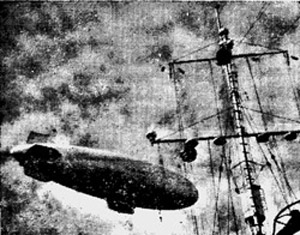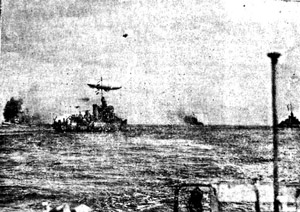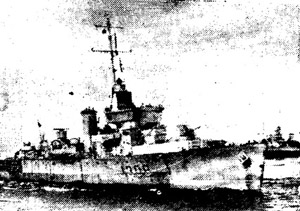Sunday Times of Malta
2nd December 1945 Pages 5 & 12
MEN WHO SWEEP THE SEAS
Their Contribution To Battle Of The Peace
19th FLOTILLA'S RECORD IN THE MEDITERRANEAN
By a "TIMES OF MALTA" Staff Correspondent
WHERE THERE'S A MINE THERE'S A MINESWEEPER AND ALTHOUGH THERE ARE NOT 40,000 MINESWEEPERS IN THE MEDITERRANEAN TO DEAL WITH THAT ESTIMATED NUMBER OF MINES, THE 19th FLOTILLA, PART OF THE ROYAL NAVY'S MINESWEEPING FLEET HARD AT WORK THROUGHOUT THE LENGTH AND BREADTH OF THE MIDDLE SEA, HAS TAKEN A GOODLY TOLL OF THIS ENORMOUS TOTAL.
STILL URGENT TASK:
The vast task of mine clearance is still urgent. In war, the minesweeper spearheaded the allied assault, sweeping the landing craft on to the invasion beaches and making lanes for bombardment units; now that peace has come the men for whom the war is not yet over, must spearhead the vast fleets of merchant ships that have still to succour a starving and war-torn Europe.
/>
In this they are assisting in great measure in winning the Battle of the Peace, for without the minesweepers and the men that man them there can be no free flow of shipping to convey supplies to the empty larders of an exhaustesd continent, of which the Mediterranean littoral is an important flank.
1,700 MINES TO CREDIT
Under Commander F.S.Walford R.N., the 19th Minesweeping Flotilla, with some 1,700 mines already to its credit - 900 of them in widening channels and clearing minefields in the Northern Adriatic since last June - has arrived at Malta to continue the vital work.
 |
 |
| Commander F.S. Woolford, R.N. senior officer of the 19th Flotilla checks the flotilla's stations from the bridge of the flotilla leader RINALDO |
ALLIED COOPERATION CAPTURED BY THE CAMERA: U.S. Navy mine-spotting blimp passes over Royal Navy minesweeper Rinaldo during operations. Black balls flying at masthead indicate mine-sweeping is in progress with the sweep out to port. |
U.S. NAVY BLIMP.
With them is a United States Navy "K" type blimp - another veteran of the Northern Adriatic. Under the command of Lieutenant G.S. Bodek, U.S. Navy, the blimp assists in minespotting; the flotilla's "watch-dog" as it were.
Though there is still that element of risk, minesweeping today is more laborious and monotonous than dangerous. Gone are the days of constant watch for enemy air or submarine attack, or of a sudden assault by a superior enemy surface force; the nerve wracking experience of sweeping off enemy-held coast and through uncharted minefields
 |
 |
| BUSY SCENE IN THE MINEFIELD:
Fleet minesweepers in the turn to commence a new lap in a field measuring some 302 square miles. Small trawlers steaming up behind are busy laying buoys marking the swept areas. U.S. Navy blimp overhead overlaps ahead of the leading sweeper keeping a sharp look-out for mines. (Right) Lieutentant Bean, R.N.V.R., navigator aboard the blimp, checks his position relative to the sweepers below. |
FLOTILLA'S WAR RECORD
After carrying out a search and clearance of the Eastern approaches to Malta the flotilla moved North to assist in the Anzio landings, but they were back again at Malta in March and cleared a minefield, said to have been laid by German aircraft off Filfia in 1942.
April saw the flotilla disperse, RINALDO to spearhead the assault on Elba while the remainnder were in operation off Panatelleria. By July the flotilla were together again clearing and extending the war channel up the West coast of Italy and then on to begin operations to open up the port of Leghorn.
EFFORT RECOGNIZED:
Nevertheless, not until the planned channels to allow free passage to unescorted shipping are swept clear can the men of the Royal Navy's minesweepers announce their task is done. It is in reconition of this fact that minesweepers are still on operatioinal duties that a recent Admiralty announcement was made granting increases in pay.
 |
| Algerine class minesweeper H.M.S. FANCY, Lieutenant-Commander J.J. Roberts, R.N.V.R., with 233 mines to her credit, turns at the edge of the minefield to commence a fresh lap. |
OLD FRIENDS
The 19th Minesweeping Flotilla are not newcomers to Malta.
Led by RINALDO as senior ship, now under the command of Commander F.S. Walford, R.N.; they include ROSARIO, Commander F.E. Brooking, R.N.; FANCY Lieutenant-Commander J.J. Roberts, R.N.V.R.; BRAVE, Lieutenant-Commander F.S. Tolliday, R.N.R.; ARIES Lieutenant-Commander Cook, R.N.; WATERWITCH Lieutenant-Commander W.G. Pitcher, R.N.R.; SPANKER Lieutenant-Commander G.S. Willis, R.N.R., and ARCTURUS, Lieutenant-Commander H.R. Grief, R.N.R., together with the dan-laying trawlers JULIET, Lieutenant H.G. Bastianen, R.N.V.R.; ENSAY, Lieutenant F.M. Cornall, R.N.V.R.; FLUELLEN, Lieutenant A.R. Ball, R.N.V.R.; MOUSA, Lieutenant G.E. Jefferies, R.N.V.R., and GRUINARD, Lieutenant G. Robinson, R.N.V.R. The flotilla operated off Malta in 1944, under the command of Commander C.H. Corbet Singleton, D.S.C. and two Bars, and succeeded Malta's famous siege sweepers SPEEDY, HEBE, HYTHE, and RYE. H.M.S RINALDO arrived at Malta on Christmas Day 1944.
There was little rest. In August the flotilla was assembled at Naples for the invasion of Southern France. The 19th Flotilla cleared the appraoches to Marseilles and came under shellfire off the Riveira while sweeping for the Navy's 'big ships' for bombardment purposes.
Returning to Malta in early September, the flotilla operated in the Gulf of Taranto and October saw it commence sweeping a channel from Ancona to Trieste. Later in the month the flotilla dispersed to assist in small-scale landings and bombardments along the Yugoslav coast.
To mark the close of a crowded year the 19th was despatched to Greece where it was in operation off Patras during the E.A.M. rising. Nevertheless, RINALDO seems to have had a penchant for Malta and she arrived here in time to give shore leave on Xmas Day.
January 1945, saw the flotilla leader join the 19th operating off Ancona and by February they were hard at it sweeping small minefields off Bari. Then down to Santa Maria di Leuca (on the 'Heel' of Italy). The flotilla was back at Ancona in April, but had had hardly time to replenish before they were ordered North to clear the channel into Trieste, working in cooperation with the 5thMinesweeping Flotilla.
"CLEAN RECORD"
Throughout operations the 19th Flotilla had had a remarkedly "clean" record. Not one sweeper had been lost, although ARCTURUS was damaged while working at high pressure to clear the approaches to Venice during the tension in Trieste, when it was decided to use Venice as the chief supply port. ARIES too, struck a mine in the Northern Adriatic, suffering five fatal casualities. She is under repair at Trieste. A dan-layer, CORIALANUS, was lost at this period, fortunately with no casualities.
LEAF FROM HISTORY
A report from the flotilla's record dated September 1945, referring to the Trieste area, reads:
"During the week ended September 15, a further 20 square miles was cleared, 102 mines being swept. Chain obstructors caused delay and Monday was a blank owing to bad weather. Mines swept: BRAVE 39, FANCY 26, SPANKER 26, RINALDO 11. SPANKER swept her 300th mine."
25,000 MINES SINCE 1939
An Admiralty minesweeping summary isued for July 1945, placed the total mines swept since the outbreak of hostilities at 25,000. During July the 'bag' amounted to 2,750 by British minesweepers throughout the world. A further 108 were swept by Allied minesweepers (excluding the U.S.A.). Of the 2,750 swept that month 1,540 were enemy laid and 1,210 were British. Of the enemy mines 880 were swept in the Mediterranean (the 19th Flotilla accounting for 330) and 218 in the Far East.
VARIED BAG
The 19th Flotilla's total 'bag' of close on 1,700 has been varied: it was only after the defeat of the Axis in North Africa and sweeping operations were opened for the landings in Sicily and the advance Northwards through Italy, that it was appreciated how extensively the enemy had peppered the waters of the Mediterranean with moored mines and strengthened the defences of the harbours with fields of magnetic and acoustic mines.
Thus the flotilla's 'bag' includes, in addition to a majority of the moored type (those that explode on contact) the more subtle magnetic (a mine that lies on the seabed and is set off by a vessel disturbing its magnetic field) and the acoustic (sensitive to sound such as a ships's engines.)
These being successfully countered the Germans went further in ingenuity and produced what is familiarly known in naval parlance as the 'Sammy' - a 9ft.cylindrical monster combining both magnetic and acoustic qualities. Then came the "Oyster" actuated by pressure of a ship under way, and finally when material began to run short, the rough and ready "Katie" made of concrete.
With the exception of the moored type, most other mines are to be encountered only in shallow water to which their limited field of activity is most suited.
On the Allied side the whole grim history of the past five years of mine warfare shows that the enemy's tactics necessitated constant changes.
Further to delay operations the enemy laid dummy mines complete in every detail, with the exception that the cable linking mine with sinker is substituted by chain which, when swept wedges itself in the sweepers's wire- cutting apparatus - and cutting by oxy-acetylene is the only method of clearing it.
"THE MINE THAT TOOK OFF"
The lighter side of 19th Flotilla's operations is told in a report of the "mine that took off."
A German mine had been cut and had come to the surface. The usual method of disposal was employed namely, fire was opned to sink it or, alternatively, explode it. Hits were observed and there followed sounds of a muffled explosion. Then, to everyone's surprise the mine "took-off" to a height of about 200 Ft. before coming down quite close to one of the sweepers and breaking uppinto small pieces.
It is assumed that the firing exploded the charge downwards thereby forcing the empty casing into the air. This would account for its disintegration on again contacting the sea.
Records kept by the 19th Flotilla show that the senior ship RINALDO has a total 'bag' of 74 mines, the ARIES and ARCTURUS (until they were damaged) 156 and 96 respectively; ROSARIO 144, WATERWITCH 268, SPANKER 379, BRAVE 318 and FANCY 233. WATERWITCH holds the flotilla and, it is firmly believed, the fleet record, of sweeping 49 mines in 17 minutes, a feat accomplished when she ran into a parallel line of mines off the Yugoslav coast, much to the discomfort of the following sweeper. "The sea looked like a sago pudding as explosions followed in quick succession," said one of the crew.
RINALDO's comparatively low 'bag' is explained by the fact that as leading ship, though not covered by a successive sweep, her own sweep is always in partly swept water, thus narrrowing her own field of activity.
(To be Continued) |







